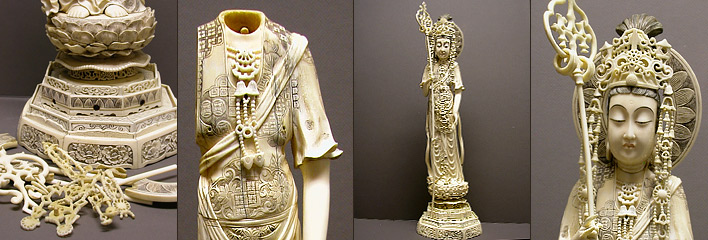Ivory/Bone Sculptures and Artifacts Cleaning, Restoration and Conservation.
Ivory - as distinguished from bone, antler or horn - includes the tusks and the unusually large or projecting teeth of animals such as elephant, walrus and several species of whale. It consists of dentine, made up of components which are both organic (to provide the capacity for growth and repair) and inorganic (to provide rigidity and strength). Identification of the type of ivory is based on the composition of the dentine and its specific growth structure.
Ivory origins, structure and properties, histological and physico-chemical. It is different types of ivory: hippo teeth, red deer antler, whale tooth, vegetable ivory and imitations. Bleaching, softening and dyeing procedures, and assembly suitable for ivory. The deterioration factors resulting changes in the ivory includes temperature, RH, anisotropy and yellowing, alteration of histological structure and of colour in archaeological ivory.
Ivory is very reactive to its environment. It bleaches when exposed to light but the most severe changes are linked to changes in relative humidity and temperature. Low relative humidity causes desiccation, shrinkage and cracking, while high relative humidity can cause warping and swelling. Heat fluctuations induce similar expansion and contraction. These problems are particularly acute with thin ivory objects, such as miniatures.
Some darkening or “patina” is the result of the natural aging process of ivory's organic constituents. Because it is porous, ivory is also susceptible to staining. It darkens in contact with the skin or oils and can be stained by corroding metals or other colored materials.
Many liquids, including water and cleaning solutions, are destructive to ivory and should be avoided.
Broken, friable or extremely dirty objects requiring restoration, consolidation or extensive cleaning should be referred to a professional conservator.
Ivory Restoration: physical and chemical desalination methods, adhesion of detached parts, consolidation, reintegration of losses and cleaning.





